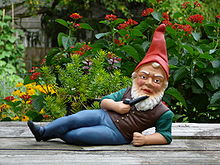
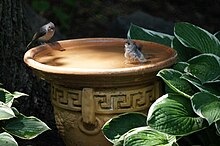

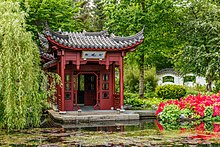

A garden ornament or lawn ornament is a non-plant item used for garden, landscape, and park enhancement and decoration.





A garden ornament or lawn ornament is a non-plant item used for garden, landscape, and park enhancement and decoration.
Early examples of the use of garden ornaments in western culture were seen in Ancient Roman gardens such as those excavated at Pompeii and Herculaneum. The Italian Renaissance garden and French formal garden styles were the peak of using created forms in the garden and landscape, with high art and kitsch interpretations ever since. The English landscape garden expanded the scale of some garden ornaments to temple follies
The Asian tradition of making garden ornaments, often functioning in association with Feng Shui principles, has a nearly timeless history. Chinese gardens with Chinese scholar's rocks, Korean stone art, and Japanese gardens with Suiseki and Zen rock gardens have a symbolic meaning and natural ornamental qualities.
Garden ornaments include:

Lawn ornaments are decorative objects placed in the grassy area of a property. [1] [2] [3] [4] [5] [6]


Sculpture is the branch of the visual arts that operates in three dimensions. Sculpture is the three-dimensional art work which is physically presented in the dimensions of height, width and depth. It is one of the plastic arts. Durable sculptural processes originally used carving and modelling, in stone, metal, ceramics, wood and other materials but, since Modernism, there has been almost complete freedom of materials and process. A wide variety of materials may be worked by removal such as carving, assembled by welding or modelling, or moulded or cast.

A statue is a free-standing sculpture in which the realistic, full-length figures of persons or animals are carved or cast in a durable material such as wood, metal or stone. Typical statues are life-sized or close to life-size; a sculpture that represents persons or animals in full figure but that is small enough to lift and carry is a statuette or figurine, whilst one more than twice life-size is a colossal statue.

A parterre is a part of a formal garden constructed on a level substrate, consisting of symmetrical patterns, made up by plant beds, plats, low hedges or coloured gravels, which are separated and connected by paths. Typically it was the part of the garden nearest the house, perhaps after a terrace. The view of a parterre from inside the house, especially from the upper floors, was a major consideration in its design. The word "parterre" was and is used both for the whole part of the garden containing parterres and for each individual section between the "alleys".
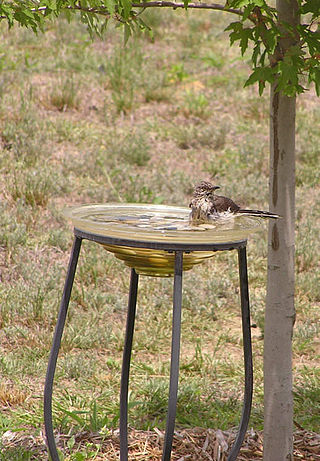
A bird bath is an artificial puddle or small shallow pond, created with a water-filled basin, in which birds may drink, bathe, and cool themselves. A bird bath can be a garden ornament, small reflecting pool, outdoor sculpture, and also can be a part of creating a vital wildlife garden.
Garden design is the art and process of designing and creating plans for layout and planting of gardens and landscapes. Garden design may be done by the garden owner themselves, or by professionals of varying levels of experience and expertise. Most professional garden designers have some training in horticulture and the principles of design. Some are also landscape architects, a more formal level of training that usually requires an advanced degree and often a state license. Amateur gardeners may also attain a high level of experience from extensive hours working in their own gardens, through casual study, serious study in Master gardener programs, or by joining gardening clubs.

The Queen Victoria Gardens are Melbourne's memorial to Queen Victoria. Located on 4.8 hectares opposite the Victorian Arts Centre and National Gallery of Victoria, bounded by St Kilda Road, Alexandra Avenue and Linlithgow Avenue.
Bernheim Forest and Arboretum, formerly Bernheim Arboretum and Research Forest, is a 16,137 acres (65.30 km2) arboretum, forest, and nature preserve located in Clermont, Kentucky.

Pink plastic flamingos are a common lawn ornament in the United States.

A lawn jockey is a statue depicting a man in jockey clothes, intended to be placed in front yards as hitching posts, similar to those of footmen bearing lanterns near entrances and gnomes in gardens. The lawn ornament, popular in certain parts of the United States and Canada in years past, was a cast replica, usually about half-scale or smaller, generally of a man dressed in jockey's clothing and holding up one hand as though taking the reins of a horse. The hand sometimes carries a metal ring and, in some cases, a lantern, which may or may not be operational.

A yard globe is a mirrored sphere displayed as a lawn ornament, typically atop a conical ceramic or wrought iron stand. Sizes ranges from 1 in (25 mm) up to 10 m (33 ft) in diameter, with the most popular gazing ball being 12 in (300 mm). Gazing balls were originally made of glass, but may now be made of stainless steel, acrylic, ceramic, or stained glass.
Donald Featherstone was an American artist most widely known for his 1957 creation of the plastic pink flamingo while working for Union Products. Featherstone resided in Fitchburg, Massachusetts, where he kept 57 plastic flamingos on his back lawn. Featherstone and his wife Nancy dressed alike for over 35 years.
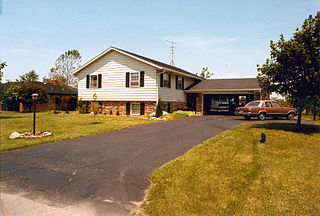
On a residential area, a front yard or front garden is the portion of land between the street and the front of the house. If it is covered in grass, it may be referred to as a front lawn. The area behind the house, usually more private, is the back yard or back garden. Yard and garden share an etymology and have overlapping meanings.
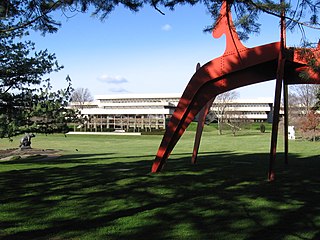
The Donald M. Kendall Sculpture Gardens is a collection of 45 pieces of outdoor sculpture at the PepsiCo world headquarters in Purchase, New York. The collection includes work from major modern sculptors including Auguste Rodin, Henry Moore, Alexander Calder, and Alberto Giacometti.
Living sculpture is any type of sculpture that is created with living, growing grasses, vines, plants or trees. It can be functional and/or ornamental. There are several different types of living sculpture techniques, including topiary, sod works, tree shaping and mowing and crop art. Most living sculpture technique requires horticultural skills, such as grafting or pruning, to create the art.

Anatomy Vessels (Saplings), 2003–05, is a public sculpture created by Indiana-based artist Eric Nordgulen (American born 1959), Associate Professor of Sculpture at Herron School of Art and Design. The sculpture is located on the Indiana University-Purdue University Indianapolis (IUPUI) campus at the Herron School of Art and Design, 735 W. New York Street in Indianapolis, Indiana in the United States. It was selected in 2005 for the Herron Gallery first Sculpture Biennial Invitational to be exhibited in the Herron Sculpture Gardens. The two-part cast and fabricated bronze sculpture represents two life size sapling trees with bound root balls.
Midway Gardens was a 360,000 square feet indoor/outdoor entertainment facility in the Hyde Park neighborhood on the South Side of Chicago. It was designed by architect Frank Lloyd Wright, who also collaborated with sculptors Richard Bock and Alfonso Iannelli on the famous "sprite" sculptures decorating the facility. Designed to be a European–style concert garden with space for year-round dining, drinking, and performances, Midway Gardens hosted popular performers and entertainers but struggled financially and the structure was torn down in October 1929.

The visual arts are art forms such as painting, drawing, printmaking, sculpture, ceramics, photography, video, filmmaking, comics, design, crafts, and architecture. Many artistic disciplines, such as performing arts, conceptual art, and textile arts, also involve aspects of the visual arts as well as arts of other types. Also included within the visual arts are the applied arts, such as industrial design, graphic design, fashion design, interior design, and decorative art.

Modern sculpture is generally considered to have begun with the work of Auguste Rodin, who is seen as the progenitor of modern sculpture. While Rodin did not set out to rebel against the past, he created a new way of building his works. He "dissolved the hard outline of contemporary Neo-Greek academicism, and thereby created a vital synthesis of opacity and transparency, volume and void". Along with a few other artists in the late 19th century who experimented with new artistic visions in sculpture like Edgar Degas and Paul Gauguin, Rodin invented a radical new approach in the creation of sculpture. Modern sculpture, along with all modern art, "arose as part of Western society's attempt to come to terms with the urban, industrial and secular society that emerged during the nineteenth century".
A Concrete Aboriginal, also known as a Neville, is a lawn ornament once common in Australia. The ornament is a concrete statue depicting an Aboriginal Australian, generally carrying a spear and often standing on one leg. The statues were once common in Australia but rarely seen since the 1980s.
The concrete Aborigine is, at its very core, a symbol of a much simpler time; an Australia that was as unashamedly kitsch as it was unaware of the cultural and political significance of something that, by today's standards, is so brutally offensive the very idea of someone trying to resurrect it as an art form would most likely prompt indignant squealing from the more progressive corners of society.